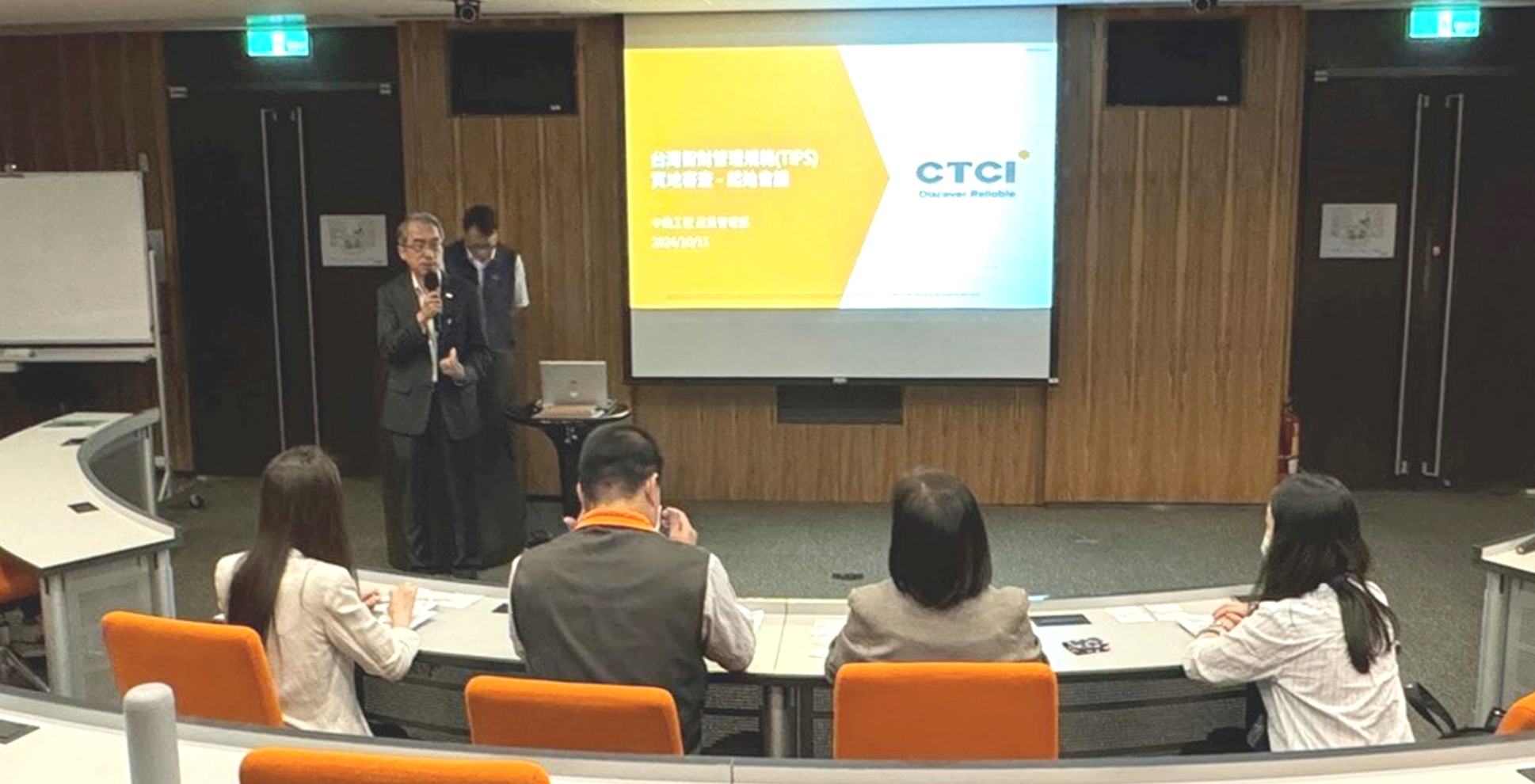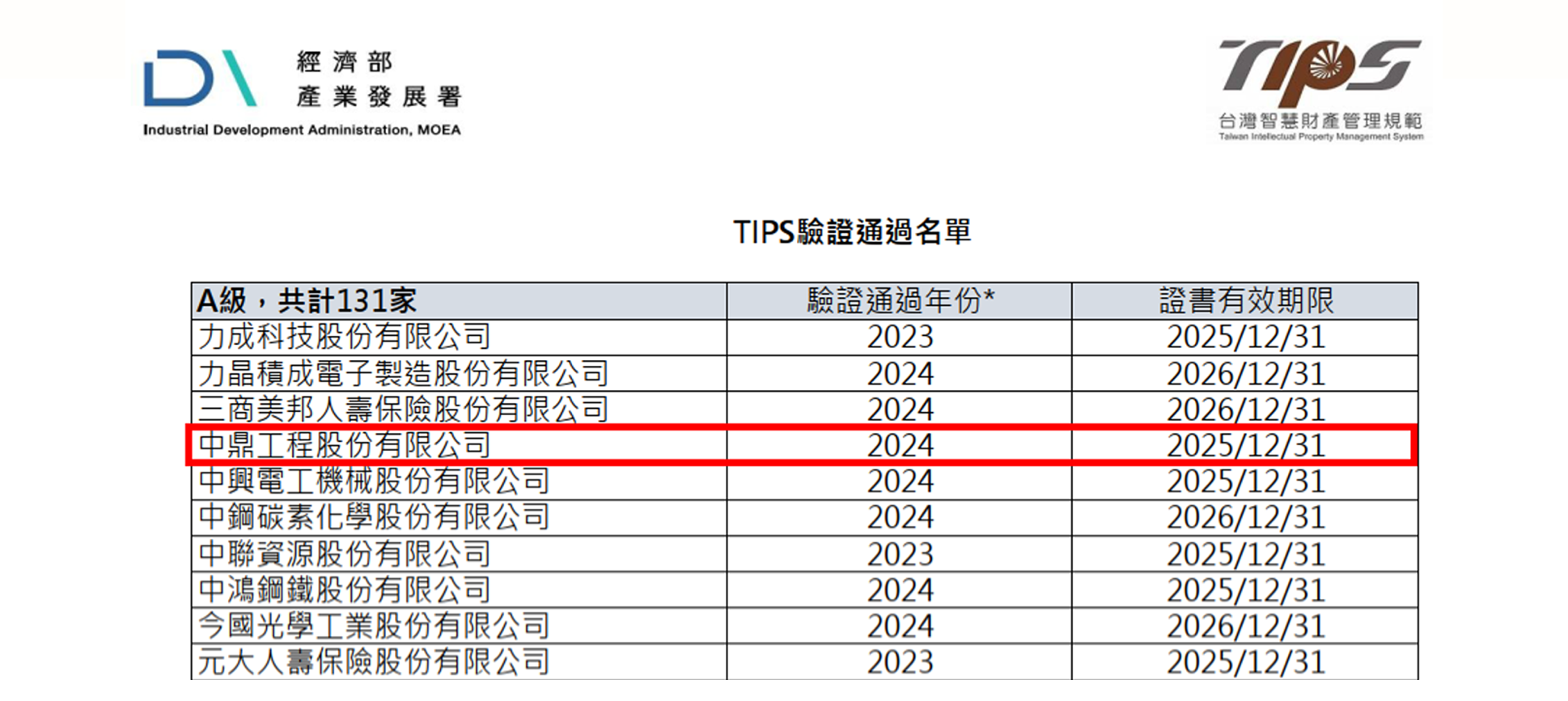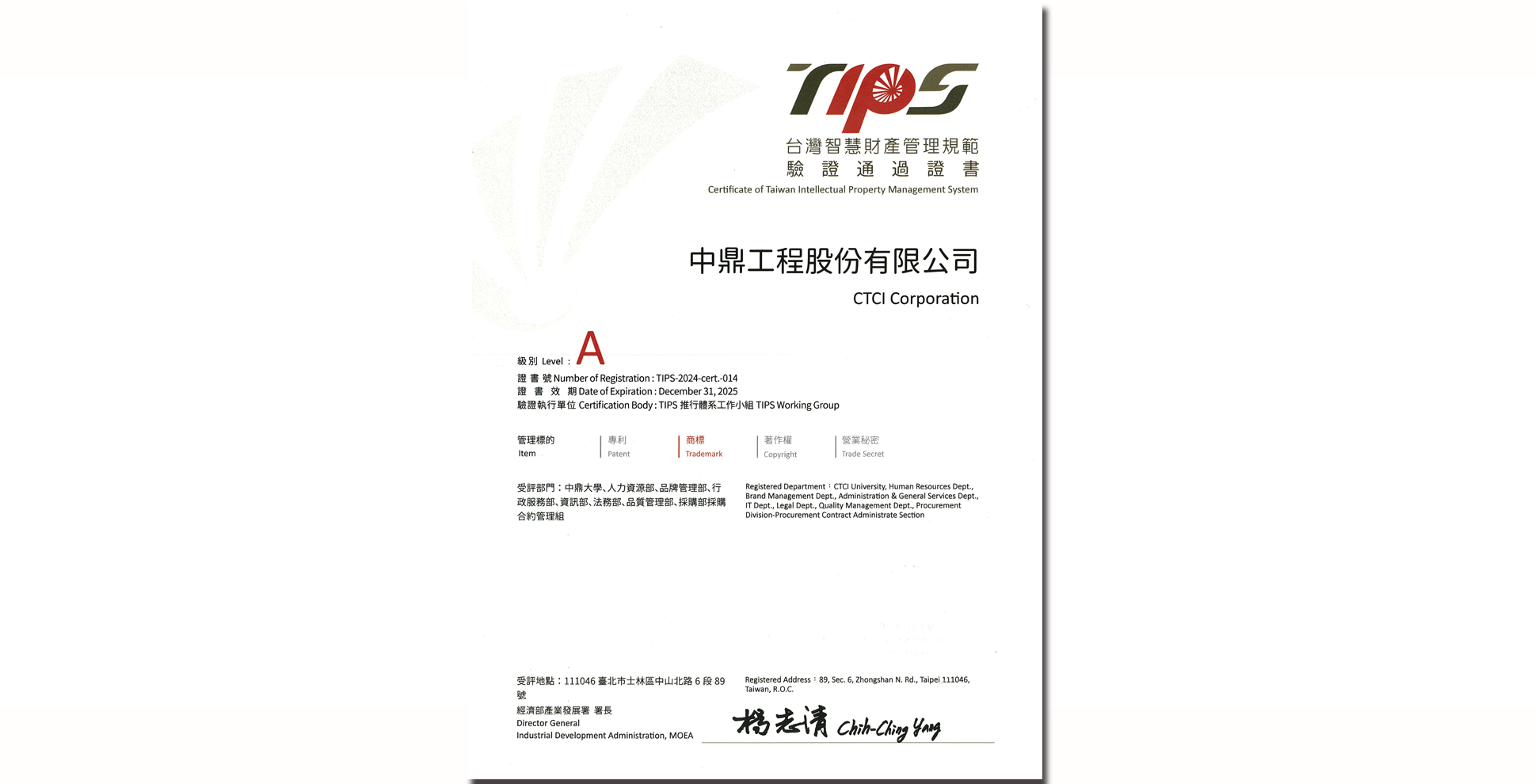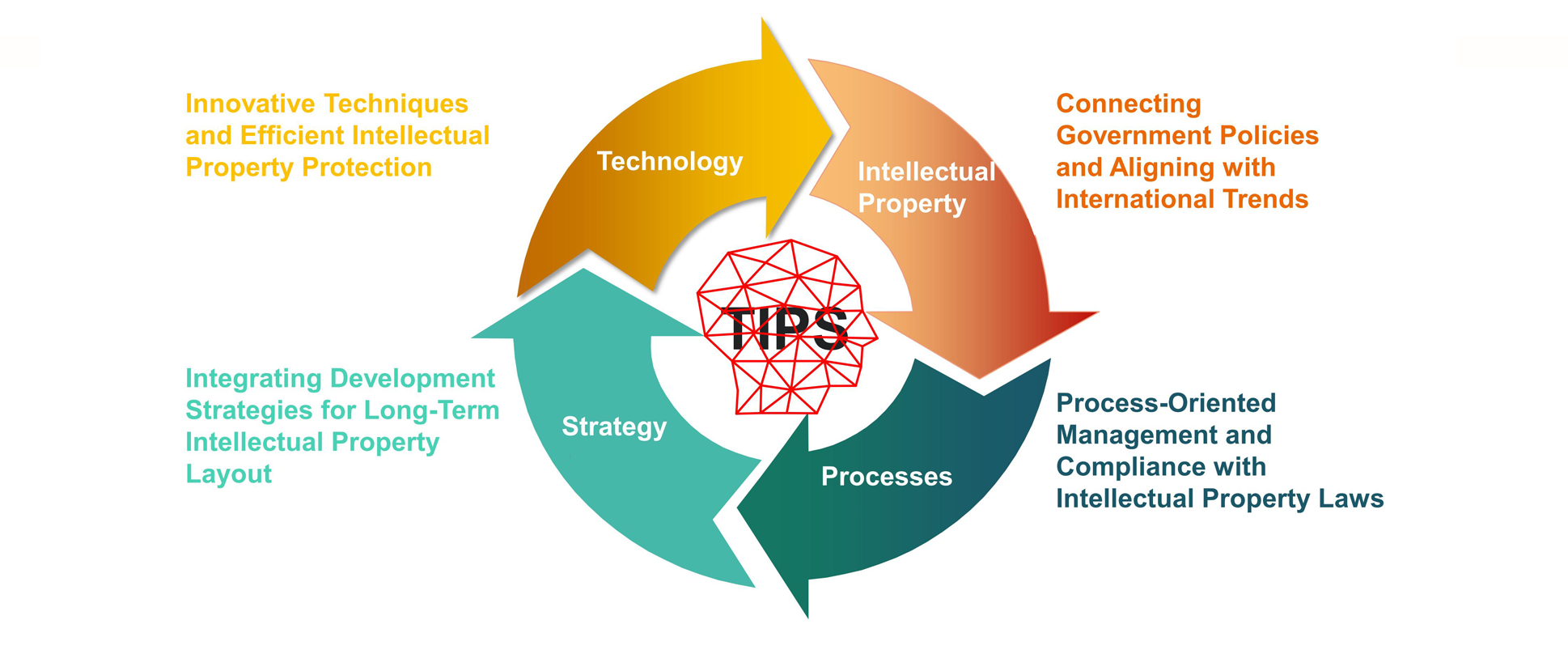Sustainable Governance
永續治理
Entering Intellectual Property Management in Corporate Governance: Discussing TIPS
In the modern corporate environment, where the core value is centered around the knowledge economy, innovation has become a key indicator of whether a company governance possesses a competitive advantage. Effective management of intellectual property rights, such as patents, trademarks, copyrights, and trade secrets, will help develop a company's innovative capabilities and competitiveness. Properly protecting research and development technologies can further promote the company's sustainable profitability and development. CTCI Corporation successfully passed the A-level on-site audit of the "Taiwan Intellectual Property Management System" (TIPS) in October 2024, becoming the first company in the Engineering, Procurement, and Construction (EPC) engineering services industry to obtain TIPS certification. Moving forward, CTCI will adopt the "PDCA cycle" framework of TIPS for intellectual property management, continuously improve its intellectual property management system based on operational direction and needs. This approach will enable CTCI to effectively manage intellectual property output, strengthen its defense against infringements, and enhance its core competitiveness.

TIPS On-site Review Kick-off Meeting dated 2024/10/11

TIPS Verification Passing List Announced by the Ministry of Economic Affairs, Industrial Development Agency dated 2024/12/31

CTCI’s TIPS A-level Verification Certificate
CTCI's Interpretation and Arrangement of TIPS
CTCI, as Taiwan's leading and one of the global top 100 EPC Group, , interprets "TIPS" from different perspectives in response to the industry characteristics and the company's operational direction. Specifically, it focuses on four elements: Technology, Intellectual Property, Processes, and Strategy. These elements interact and cycle together to construct a comprehensive and robust intellectual property management framework. The following is a detailed explanation of each element:

Technology Aspect: Innovative Techniques and Efficient Intellectual Property Protection Technological innovation is the foundation for the development of intellectual property and the enhancement of competitive advantages for enterprises. By researching and developing new technologies, companies can effectively expand markets, reduce engineering costs, and improve construction efficiency, service quality, and added value. First, during the early stages of new technology development, it is essential to simultaneously implement intellectual property strategies to prevent technology leakage, replication, or infringement by competitors. Second, continuous technological updates and research investments help maintain competitive advantages and prevent products and technologies from becoming outdated, ensuring leadership amid changes. Furthermore, innovative technologies can only be transformed into sustainable competitive advantages when they are effectively protected. Therefore, CTCI's adoption of the TIPS provides a comprehensive intellectual property protection mechanism, effectively safeguarding the company's technological achievements from being easily imitated by competitors. Intellectual Property Aspect: Connecting Government Policies and Aligning with International Trends Since 2014, the Financial Supervisory Commission has conducted corporate governance evaluations, and in 2020, it included "Intellectual Property Management Evaluation Indicators" as a key focus in the governance evaluation system for listed companies. Additionally, to align with ESG trends and accelerate the promotion of corporate governance for listed companies, the stock exchange has drawn on the "2030 United Nations Sustainable Development Goals (SDGs)" and, according to the "Sustainable Development Action Plan for Listed Companies," has identified the ESG performance of listed companies. Starting in 2026, the "Corporate Governance Evaluation for Listed Companies" will be transformed into an "ESG Evaluation," with item 2.27 "Intellectual Property Management Evaluation indicator" included. Therefore, the introduction of the TIPS not only helps CTCI consolidate and enhance its corporate governance evaluation ranking but also aligns with relevant regulations regarding patents, trademarks, and ISO 56001:2024 (an international standard for innovative management systems that identify, assess, and protect intellectual property assets). This ensures that CTCI enjoys proper intellectual property protection at every stage of intellectual property development, from technological innovation to market promotion in the international market. Processes Aspect: Process-Oriented Management and Compliance with Intellectual Property Laws Effective intellectual property management requires systematic support through a PDCA Cycle Process Approach. Therefore, it is essential to continuously and systematically optimize management processes, including clear procedural specifications for technological research and development, creative applications (such as patent applications and trademark registrations), and the daily maintenance and risk control of intangible assets. The specific implementation methods include regularly revising existing procedural documents, conducting periodic intellectual property audits to review the status and value of existing intellectual property assets, checking for potential infringement risks, and determining whether updates and ongoing maintenance are necessary. It also involves identifying intellectual property that no longer holds strategic significance and handling it appropriately, concentrating limited resources on promising targets, and promptly acquiring the immediate status of intellectual property assets. Additionally, it is crucial to understand the intellectual property laws of different regions to ensure that the intellectual property rights possessed are up-to-date and compliant, thereby reducing potential legal impacts and maintaining a favorable position in market competition. Moreover, a professional team should handle intellectual property-related matters, implementing internal education and training mechanisms to enhance the awareness of intellectual property protection among all employees. Therefore, CTCI's introduction of the TIPS and strengthening of intellectual property management not only allows for timely responses to intellectual property impacts and enhances intellectual property rights protection functions but also enables effective use of judicial support in litigation, ensuring proper evidence presentation and swift resolution of intellectual property disputes. Strategy Aspect: Integrating Development Strategies for Long-Term Intellectual Property Arrangement Intellectual property management should be guided by a clear strategy that aligns with the company's long-term development strategies and governance goals. It should also be adjusted according to market dynamics and competitive conditions, incorporating intellectual property arrangement into the overall business strategy. Thus, a clear strategic arrangement for intellectual property must be designed, from identifying innovative technologies to how these technologies can be transformed into market advantages, including global patent arrangements, trademark brand management, and intellectual property cooperation and licensing strategies, to prepare for international protection of intellectual property. In summary, before expanding operations into new markets, companies should ensure trademark registration and patent protection to avoid intellectual property disputes during business expansion. Different management strategies should be adopted for different types of intellectual property, such as actively applying for and maintaining trademarks, strictly controlling trade secrets internally to prevent leakage of commercial secrets, and establishing technology patent alliances to protect technological advantages, expand market applications, innovate profit models, and secure stable revenue.
Conclusion
The introduction of TIPS and the implementation of intellectual property management present an opportunity for enterprises to grow steadily in a global business environment filled with challenges and opportunities. CTCI combines the framework of the Taiwan Intellectual Property Management System (TIPS) with an efficient intellectual property protection mechanism, enhancing its existing intellectual property management system through Technology (T), Intellectual Property Protection (I), Process Management (P), and Strategic arrangement (S). Domestically, this lays the foundation for the internationalization of technological services and innovative achievements in intellectual property protection while preventing infringement and avoiding leaks, thereby comprehensively enhancing intellectual property awareness. Internationally, it transforms intangible intellectual property assets into tangible economic value, significantly enhancing innovation capabilities and brand value, consolidating brand image, strengthening market recognition, and protecting the brand from imitation or infringement by competitors. This effectively addresses challenges from different markets, ensuring CTCI's uniqueness and competitive advantage in the international engineering contracting market, helping the company maintain an undefeated position in global intellectual property arrangement and uphold sustainable governance.


